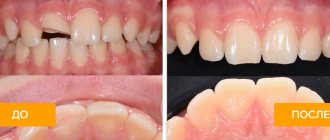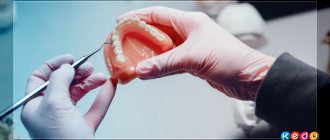What is a “dentist” like?
- good
- (more. )
Reference information on the declension of nouns and adjectives, verb conjugation, as well as the morphemic structure of words.
Who is a dentist?
Before dealing with narrow specializations, let’s consider who a dentist is in general. This is a doctor who has a higher education and has the right to carry out all types of dental treatment from therapeutic to prosthetics.
There are also dentists. Despite the fact that people call all dentists this way, in fact they are specialists with secondary specialized education. Their field of activity is dental treatment, but they do not have the right to undergo surgery.
In addition to dentists who work directly with patients, there is a dental technician. This specialist is engaged in the manufacture of prosthetics.
The second name of this specialist is odontologist. The main function of this doctor is to treat caries and its complications. The first thing you meet with a dental therapist is when you come to the dental clinic. He makes an initial examination and decides on treatment methods. His qualifications are sufficient to install fillings in carious cavities. During the filling process, the doctor examines each tooth individually in order not only to cure caries, but also to recognize other defects. He also treats gums and other inflammatory processes in the oral cavity. A dental therapist can diagnose the disease and select individual treatment or refer you to another specialist.
Dentist profession
A dentist has more authority regarding the conduct of medical procedures. Specialty training lasts 6 years, during which doctors master several important disciplines. Upon completion of training, the specialist is asked to choose one of the areas: therapist, surgeon, orthodontist, orthopedist or hygienist.
Comprehensive training is necessary in order to know the structure of the human body and be able to establish the relationship of one organ with another. The doctor also has to master the basics of psychology, since some patients come to the office in a depressed state, which aggravates the therapy.
Each category in dentistry should be considered in more detail.
In some cases, the dentist is unable to provide assistance to a small patient. This is due to several factors:
What is the difference between a dentist and a dentist: who is he and what does he do?
The word “dentist” is rarely used in our country; most often this is the name given to foreign specialists involved in the treatment of oral diseases. In the Russian-speaking environment, it is synonymous with the concept of “dentist”.
Orthopedic dentist - description of specialty
The name “orthopedic dentistry” was given to medical qualifications for the protection, restoration and prosthetics of the maxillofacial area. Sooner or later, every person needs to protect damaged tissue with a crown or prosthetics. The rating of dentists is opened by an orthopedist.
Situations in which the help of an orthopedist is needed:
- Tooth decay and loss. In this case, its function is restored by installing an artificial one.
- Protection from destruction. If only part of the bone tissue has been corroded, and the roots are intact and healthy, a crown is installed on such dental tissue, which stops further destructive process.
- The teeth are completely intact and healthy, but their appearance does not suit the owner. Installing ceramic plates will eliminate problems such as chips and scratches.
If the tooth tissue and root are healthy, then restoration is sufficient. Otherwise, prosthetics are performed. To determine what treatment plan is needed, the doctor conducts an examination, after which he makes a dental modeling in his laboratory. The orthopedist also deals with the correction of the appearance of the dental system, i.e. issues of aesthetic dentistry.
- Tooth decay and loss. In this case, its function is restored by installing an artificial one.
- Protection from destruction. If only part of the bone tissue has been corroded, and the roots are intact and healthy, a crown is installed on such dental tissue, which stops further destructive process.
- The teeth are completely intact and healthy, but their appearance does not suit the owner. Installing ceramic plates will eliminate problems such as chips and scratches.
Diagnostic and treatment methods
Dental treatment in therapeutic dentistry begins after diagnosis. The doctor examines the oral cavity, studies the patient’s complaints and medical history. As a rule, to determine the type of disease and the causes of its occurrence, the dentist only needs the results of an examination and an x-ray of the affected tooth. In difficult cases, orthopantomography, electroodontodiagnosis, functional and biological tests are required to clarify the diagnosis.
Depending on the diagnosis, filling, cleaning of dental plaque and plaque, depulpation with root canal filling, enamel restoration and other therapeutic procedures can be performed.
What types of dentists are there?
Prothodontists, orthodontists, or prosthetists work to create artificial teeth such as dentures, custom implants, and bridges. They can communicate with patients, participate in research and carry out orders related to the development of artificial teeth individually for each customer.
What are the responsibilities of such a specialist?
There are cases when teeth that normally perform chewing work look unattractive in appearance, causing awkwardness when communicating with others and emotional distress in a person. The problem can be solved with the help of veneers (overlay porcelain plates) that eliminate cosmetic defects (discoloration, shape) of the front teeth.
In one or two appointments, the orthopedist will use ceramic veneers to make your smile visually flawless and provide protection for the outer layer of the incisors. The service life of the linings is from 3 years, depending on the materials, installation method, and the skill of the doctor.
It is recommended to cover dental units that are weak in structure and susceptible to destruction with a crown to avoid the risk of their splitting and to prevent rapid deterioration. To prevent destruction and rapid loss of a damaged tooth, dentures are used to completely or partially restore it.
A high quality of life becomes impossible with excessively damaged, partially missing molars. Difficulty chewing food has a detrimental effect on the functioning of the gastrointestinal tract, causing diseases of the digestive system and other problems. In addition to the importance of the front incisors for aesthetic reasons, the role of other teeth is no less important: canines, premolars, molars. You should not consult a dentist if you have pain, the last stage of tooth decay, when the provision of orthopedic care becomes very difficult. If you lose any dental units (even distant ones), you need prosthetics to avoid stress on the teeth and their premature destruction.
The absence of molars as a result of periodontal damage, an accident, or in elderly people requires restoration of the dentition by an orthopedist using removable dentures. Such prosthetics were not an easy test for patients; the “false jaws” were bulky and uncomfortable. The materials for their manufacture (toxic and inelastic) did not fit well under the gums, often causing an allergic reaction, rubbing, and irritation of the soft tissues of the mouth.
Modern materials used for crowns and bridges do not wear out and last for many years (as a rule, they should be changed after 7 years), unless oral problems arise: weakening of the periodontium, exposure of the neck of the tooth, infection and inflammation of the root.
The durability and strength of crowns depends on the material:
- metal (steel, titanium, gold, platinum),
- metal ceramics (metal base with ceramic coating),
- ceramics with the addition of zirconium dioxide for strength,
- plastic can be used for temporary crowns.
When installing crowns, the root remains alive, the crown part of the tooth is corrected, the method is cheaper than implantation, which is the advantage of crowns. Disadvantages of restoring a tooth with a crown: the need to file the main and adjacent teeth, the risk of inflammation and tooth destruction in case of unsuccessful prosthetics.
If several dental units are lost in a row, a bridge (cast, metal-ceramic or ceramic) is made, which is placed on the supporting teeth. Bridges are durable and affordable, but, unfortunately, you have to file down the supporting teeth.
Fully or partially removable dentures are used to restore chewing function in the absence of a dental row.
Several dentists of different specializations are involved in the process of prosthetics.
According to the job description, the orthopedist is obliged to:
- prescribe an examination, select a treatment method,
- select a design and material for it (to be agreed with the patient),
- familiarize the patient with the treatment plan (indicating the dates of the visit, the production time of the product planned by the dental laboratory).
- try on, adjust and correct the finished product:
- install and fix a crown, bridge, prosthesis,
- remove the prosthesis if necessary, assess its condition,
- give recommendations to the patient on how to care for the structure.
In the manufacture of prosthetics, modern orthopedics uses special computer programs and the latest materials and innovative methodological developments.
Defects and anomalies of dental units that do not allow a person to chew fully, smile freely, or talk can seriously poison a person’s life: give rise to a lot of complexes and bring physical and moral suffering. Prosthetics is a dental service in any country in the world. The variety of dental services is complemented by the development of techniques and materials used.
Dentist profession
A dentist has more authority regarding the conduct of medical procedures. Specialty training lasts 6 years, during which doctors master several important disciplines. Upon completion of training, the specialist is asked to choose one of the areas: therapist, surgeon, orthodontist, orthopedist or hygienist.
Comprehensive training is necessary in order to know the structure of the human body and be able to establish the relationship of one organ with another. The doctor also has to master the basics of psychology, since some patients come to the office in a depressed state, which aggravates the therapy.
Each category in dentistry should be considered in more detail.
Therapist
The doctor treats the diseased tooth and installs a filling. The dentist also copes with these responsibilities. Both specialists can also examine the patient’s oral cavity and diagnose the disease. The difference between a dentist and a dentist is that a dentist solves minor problems (gum inflammation, mild caries). All the therapist’s work is aimed at combating advanced caries and its consequences (pulpitis, periodontitis, dental cysts, etc.). Let’s take a closer look at each of the diseases that the dentist deals with.
In the photo, pulpitis is one of the complications of caries that requires dental care.
Caries is caused by the gradual destruction of the enamel elements. If treatment is not timely, the pathological process spreads to dentin and pulp. The problem arises under the influence of negative external factors: taking certain types of medications, consuming carbohydrate-containing foods, and lack of proper oral care.
One of the complications of caries is pulpitis, in which the nerve endings of the tooth are involved in the pathological process. The main symptom of the disorder is acute severe pain, which is difficult to relieve even with potent drugs. Pulpitis requires immediate treatment from a dentist.
Periodontitis develops as a result of bacterial infection of the jaw bones. The condition can cause complete or partial edentia (loss of teeth).
Another problem that the dentist deals with is periostitis (flux). The disease is accompanied by severe swelling of the soft tissues of the mouth and intense pain.
The competence of the general practitioner also includes solving non-carious problems:
- demineralization of enamel;
- fluorosis;
- wedge-shaped defects;
- enamel abrasion;
- necrosis of bone tissue.
- increased sensitivity of teeth;
- diseases of the mucous membranes of the mouth (stomatitis, periodontitis, gingivitis).
There is no difference between a dentist and a dental therapist. Both specialists deal with general problems and provide referrals to specialist doctors if necessary.
Some private clinics provide services to restore the aesthetics of a smile. They include enamel whitening, elimination of bad breath, and dental restoration with reflective composites. All of the above types of services are provided by dental therapists.
Orthodontist
The main task of the doctor is to perform prosthetics. The doctor restores the chewing function of the jaw in the absence of one or more elements in the oral cavity. In addition, with the help of orthodontic structures, the aesthetics of a smile is restored, thanks to which a person ceases to be embarrassed by others.
Another name for an orthodontist is a prosthetist. First, all patients see a therapist, who issues a referral to an orthodontist.
The differences between the specialist in question and the dentist are obvious: the first is engaged in restoring the shape and aesthetics of the tooth, the second is in treatment.
Today, orthodontists are in increasing demand. They can offer patients modern prosthetic options to solve various occlusion problems. Orthodontic structures differ in purpose, cost and installation time. In each specific case, the doctor selects the best option for the patient.
Surgeon
If the tooth enamel or pulp of the element is severely destroyed, then the only way out is tooth extraction. What kind of doctor removes teeth? This function is performed by a dental surgeon. The doctor is also involved in other activities:
- performs maxillofacial surgeries;
- prepares the oral cavity for implant installation;
- corrects dental anomalies;
- gives advice on correcting malocclusions.
The surgeon performs a list of rather complex tasks that a dentist-therapist cannot cope with. After extraction of the problematic unit, the surgeon gives advice on caring for the oral cavity to minimize complications and speed up wound regeneration.
Orthopedist
What does an orthopedic doctor treat? The specialist is engaged in the restoration and correction of defects of the entire musculoskeletal system. He, like an orthodontist, can save a unit whose coronal part is destroyed but the root is intact. The differences between the specialists in the profile under consideration are that an orthodontist deals only with dental problems, while an orthopedist solves a wider range of problems related to joint damage, etc. Orthopedics also provides for dental implantation and prosthetics if there are problems with bite.
Orthopedic structures to normalize the bite
Pediatric dentist
The structure of the jaw in children has some differences, so separate specialists deal with the elimination of dental diseases in children. The doctor knows what filling materials and anesthetic agents can be offered to young patients.
The opinion that children do not need to have their baby teeth treated is wrong. Carious processes can spread to the pulp, nerve endings of the element, as well as periodontal tissue, which in the future will create problems in the formation of a permanent bite. To treat children, the doctor will have to use not only other drugs, but also instruments. In addition, the pediatric dentist must have the skills of a psychologist to prepare the patient for the upcoming procedures.
Hygienist
This profession is considered relatively new in dentistry. The main goal of the specialist is to properly care for the patient’s teeth and teach the patient hygiene skills. The list of services provided by the doctor includes:
- diagnosis of oral diseases;
- professional enamel cleaning;
- prevention of caries;
- medical examinations in various institutions (kindergartens, workplaces, schools).
What is the name of a dentist?
Modern dentistry provides a range of services, so today there are more and more different specializations in this field.
Dental professions:
- Dentist;
- dentist;
- orthopedist;
- orthodontist.
In this article we will discuss each specialization separately. You will learn: what is the name of the doctor who inserts teeth, and also whether a dentist has the right to remove teeth, which doctor treats stomatitis, and much more.
Dental professions:
What is the difference between these concepts?
The difference between a dentist and a dentist is the level of training and the type of treatment they can perform.
The list of works provided for in the job description of a dentist includes:
- A dentist is a general specialist
diagnostics;
- treatment of relatively simple diseases of teeth and gums - gingivitis, stomatitis, caries and some others;
- removal of teeth not complicated by periodontitis;
- treatment of simple maxillofacial injuries.
- carrying out physical procedures;
- consultation regarding the choice of oral hygiene products;
- cleaning teeth from plaque and tartar, and some others.
In case of more serious dental pathologies - malocclusion, pulpitis, periodontitis, periodontal disease, lesions that have caused tooth destruction by more than 50%, and in other cases requiring the participation of a more trained specialist, the dentist gives the patient a referral to a dentist of the appropriate specialization.
A dentist is a general specialist. He has theoretical knowledge and practical skills sufficient to perform therapeutic, orthodontic, orthopedic and surgical operations.
Although, like a dentist, when faced with a particularly difficult case, he can refer the patient to a doctor of a narrow specialization.
How to find a good specialist?
Today there are many dental clinics, most of them offering prosthetics services. Crowns, bridges and other orthopedic structures are installed for a long time and are expensive, so no one wants to end up in the hands of an amateur. What should you pay attention to when choosing a doctor?
- Patient reviews. There are several sites on the Internet where patients share information about the doctor’s work. The most important reviews are from patients whose orthopedic construction has been in place for more than one year, this is an indicator of qualified work.
- Is a prosthetist on the staff of the dental center? Many clinics invite outside specialists to come for 2-3 hours a week. If problems arise after prosthetics, finding the doctor who performed the procedure will not be easy.
- It makes sense to come for a consultation and discuss issues of interest with the doctor in a personal conversation. It is important to understand what diagnostic tests he will prescribe, how he will draw up a treatment plan, and whether he will take into account the patient’s health condition. The answers to these questions can tell a lot about the professionalism and responsibility of a doctor.
Average prices for a doctor's consultation
The cost of a doctor’s consultation and the prosthetics itself depends on the complexity of the case, the materials used, and the clinic’s pricing policy. Average prices in Moscow are as follows (in rubles):
| Clinic | Consultation | Installation of a metal-ceramic crown |
| European Dentistry Center | For free | 7990 |
| All yours | For free | 8300 |
| Art-Stom | For free | 10400 |
| Alpha-Dent | 300 | 7000 |
Pensioners and some other categories have the right to free prosthetics if they have a compulsory medical insurance policy, but in this case they will not be able to choose a doctor.
What is an intraoral scanner used for?
Using an intraoral scanner, you can immediately scan the patient’s teeth directly and immediately receive a digital 3D model of the teeth online. That is, teeth are scanned instead of taking classical impressions.
What are the advantages of intraoral scanners? First: convenience and comfort for the patient. There are a number of patients who cannot tolerate conventional impression materials. They develop a gag reflex - for example, it is very common in children.
And for such patients, intraoral scanning is probably the only possible way to make a digital impression of their teeth. Second, intraoral scanning allows for significantly higher accuracy than traditional impressions.
For example. When we make a high-precision A-silicone impression of teeth, then cast a plaster model for 3D scanning in a laboratory scanner, at the stage of taking the impression and casting the plaster model, an error of about 100 microns is obtained. Modern intraoral scanners provide 5-7 times higher accuracy – up to 12 microns.
Accordingly, the digital model obtained using intraoral scanning is significantly more accurate. This is very important for orthopedics, in the production of crowns, and it is also important in the production of aligners. Why? Because the aligner works by fitting the teeth very well. And if the impression is not accurate enough, this means that in some places the aligner will not fit the teeth enough, will not press as expected, and, accordingly, some of the movement of the teeth may not happen because of this.
This rule is confirmed by the statistics of our company. We see that clients who use intraoral scanners in their practice, in their clinics, have a significantly lower revision rate than those clients who work with traditional impressions, even if they use high-precision A-silicone.









